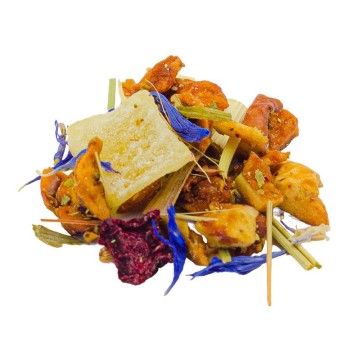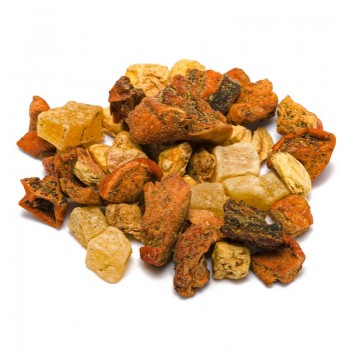The characteristic aroma of the relaxation infusion comes from the mixing of various natural essences, combined in order to enhance the benefits: relaxing effects for the body.
This drink, if taken on a regular basis, can relieve stress disorders, anxiety, nervousness, agitation, irritability. Furthermore, it is useful for relieving sleep disorders (insomnia, nocturnal awakenings) and promoting a state of calm and relaxation, especially in the evening. It is an excellent drink to relieve everyday tensions of work and stress.
Relaxing infusion: properties and benefits
The lemon balm contained in the infusion acts effectively: it relaxes the muscular system and calms the nervous system.
This plant has been known since ancient times for its excellent properties as a natural sedative, to reduce anxiety and help correct sleep. By relaxing the muscles, it ensures a valid effect against stress at the end of the day, or in moments of tension.
The relaxing effects of lemon balm are enhanced with those of chamomile, increasing the content of calming elements such as the flavonoid apigenin . This substance acts on the receptors in our brain, inducing a feeling of relaxation. Therefore, it promotes sleep with a rebalancing action on the nervous system. Already in ancient times these plants were known for their interaction with our psycho-physical state.
Today it is thought that the neurosedative mechanism of action is due to an activity linked to the thyroid,
This mix of medicinal plants plays an active role for the nervous system, also useful for giving support in the case of painful psychosomatic states, such as nervous migraines, palpitations and tachycardia, dizziness, buzzing and tinnitus due to stress and trauma.
The neurovegetative disorders of menopause and premenstrual syndrome can benefit from a relaxing infusion taken regularly.
The muscle relaxant properties (to relax the muscles) are ideal for relieving tension in this phase, and also during menstruation.
In addition, the combination of chamomile, mallow and lemon balm flowers is also useful for relieving digestive or intestinal disorders. The relaxation infusion can be used to reduce swelling and intestinal gas, also thanks to the presence of fennel.
Lemon balm has actions against intestinal spasms and as a calming of gastric irritations. It joins the mallow, able to provide protection for the mucous membranes in case of heartburn, and also beneficial for the urinary tract.
The infusion is a sedative of the gastrointestinal tract, with its sedative abilities, which can combine the evening with a digestive well-being action, and promote a good rest.
Origins and History of cultivation
In this rich mix intended for calming infusion, there are several elements that help the well-being of the nervous system and digestive system.
Many ingredients are used to create this infusion: chamomile flowers, mallow, lemon balm, hibiscus, rose hips, pieces of apple, fennel seeds. These are foods historically known to our culture for centuries, with the exception of hibiscus, known in Asia and widespread in Europe only in the 15th century.
In particular, chamomile and lemon balm were already known in ancient times as relaxing and soothing medicinal plants. Chamomile is native to Europe and Asia, and was defined by the ancient Greeks as apple of the earth (khamaìmelon) for its intense aroma. It is a plant that grows spontaneously and is easily found in meadows between spring and the end of summer.
Lemon balm is a plant native to Eurasia, which also grows spontaneously along paths, hedges and ruins. Already in the tenth century the Arabs used it against melancholy, for its qualities on mood, and later in the Middle Ages it became an "anti-hysterical" water, calming the nerves and mental disorders.
Its name comes from the same root as honey, because its scent attracted bees.
Among the other ingredients is mallow, a plant of European origin whose name derives from the Greek malakos, soothing sweet, and from the Latin mollire, emollient. We find it in all Mediterranean areas and it grows spontaneously up to 1300 m of altitude. Already sacred to the Greeks, in the Middle Ages it was considered both ornamental and magical - for the Celts, it chased away evil spirits. Over time it became an important food in calming and soothing potions.
We can insert these ingredients in an infusion with excellent calming and relaxing qualities. We can obtain it in all seasons, thanks to the drying processes.
Plant and flowers
The components of the infusion are many, and the mixture contains fruits, seeds and flowers of various origins. We offer hibiscus, rose hips, pieces of apple, fennel seeds, chamomile flowers, mallow, lemon balm.
Melissa officinalis is a plant belonging to the Lamiaceae family, known for its sedative properties . It blooms from summer to autumn, and has a mint-like appearance.
chamomile comes from the flowers of Matricaria chamomilla, part of the Asteraceae, the botanical family of daisies. The Malus domestica plant of the Rosaceae family gives us apples. It is a tree native to Asia, now widespread throughout the planet. The fruits are diversified in colors and in the many varieties.
The Malva sylvestri s, is a plant that belongs to the Malvaceae family. It is a perennial herbaceous plant, with lilac-colored flowers. Fennel (Foeniculum vulgare) is a flowering plant of the Apiaceae family (Umbelliferae). The variety of wild fennel is distinguished from the sweet fennel of horticultural cultivation.
The Rose is a plant of the Rosaceae family, native to Asia. There are thousands of cultivars of this plant, famous for its flowers, which can be of many shapes and colors.
The Hibiscus (Hibiscus) is a plant of the Malvaceae family, native to the warm temperate, subtropical and tropical regions. The large flowers are dried and consumed for their beneficial properties.
Nutritional values of the relaxation infusion
The components mainly contain substances capable of promoting relaxation or digestive well-being. They make citronellal, citral, eugenol acetate and geraniol, sesquiterpenes, triterpene acids (ursolic, oleanolic acid) bioavailable.
There are polyphenolic acids (rosmarin, chlorogenic, caffeic, etc.), precious tannins and flavonoids including luteolin, apigenin, isoquercitrin.
In mallow we find malvina and malvidina, while in fennel there is the famous anethole, as well as compounds useful for well-being such as fencone, estragon and limonene.
In addition, some components are rich in vitamin C,
How to use the ingredients in a relaxing herbal tea
The infusion is obtained by putting the mixture of fruits, flowers and seeds with water at 100 ° C into a cup (250 ml).
Leave to infuse for 10 to 12 minutes, before drinking the relaxation herbal tea.
Add honey or sugar if desired.
Relaxation infusion: side effects and contraindications
The calming herbal tea generally does not cause particular side effects, but it is necessary to respect the recommended quantities.
When taken in excessive doses, the infusion can provide opposite phenomena such as anxiety, agitation and irritability. In addition, it can cause episodes of gastrointestinal disturbances, and nausea.
A rare side effect is linked to possible allergic reactions due to individual ingredients, so it is good to carefully read the composition of the relaxation infusion.

![infuso relax [Natura d'Oriente] infuso relax [Natura d'Oriente]](https://www.naturadoriente.com/3555-large_default/infused-relaxation.jpg)




![infuso relax [Natura d'Oriente] infuso relax [Natura d'Oriente]](https://www.naturadoriente.com/3555-home_default/infused-relaxation.jpg)




 No reward points for this product.
No reward points for this product.















